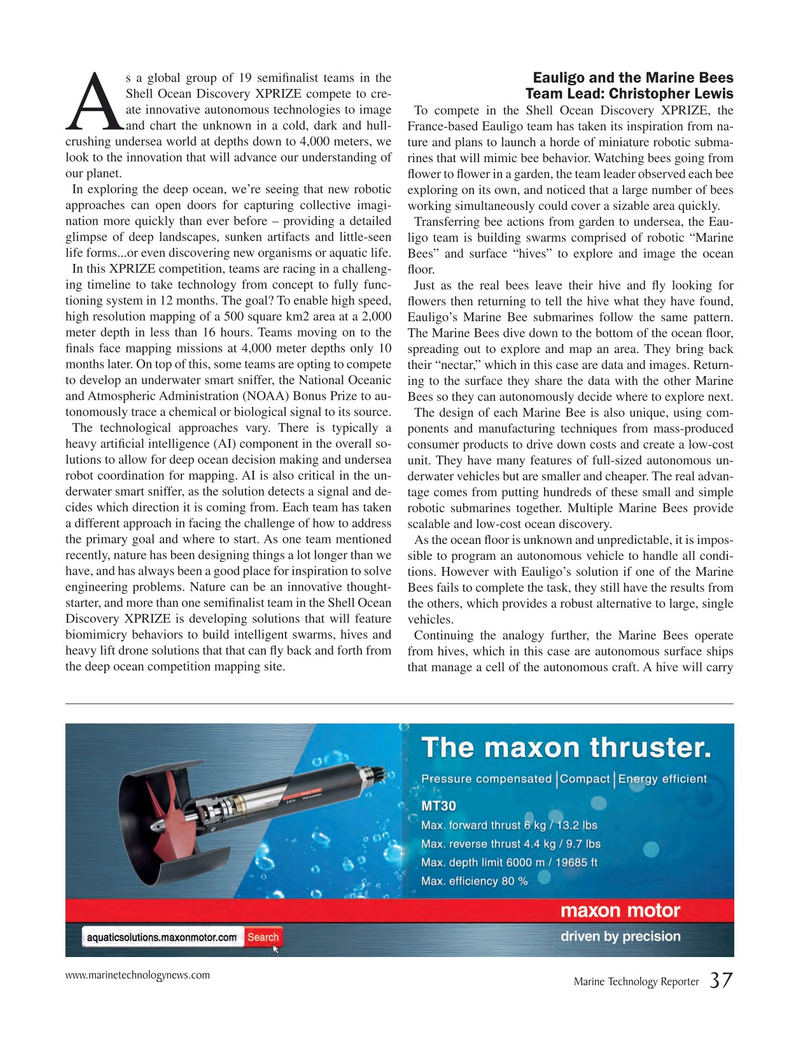
Page 37: of Marine Technology Magazine (September 2017)
Ocean Observation: Gliders, Buoys & Sub-Surface Networks
Read this page in Pdf, Flash or Html5 edition of September 2017 Marine Technology Magazine
s a global group of 19 semi? nalist teams in the
Eauligo and the Marine Bees
Shell Ocean Discovery XPRIZE compete to cre- Team Lead: Christopher Lewis ate innovative autonomous technologies to image To compete in the Shell Ocean Discovery XPRIZE, the
Aand chart the unknown in a cold, dark and hull- France-based Eauligo team has taken its inspiration from na- crushing undersea world at depths down to 4,000 meters, we ture and plans to launch a horde of miniature robotic subma- look to the innovation that will advance our understanding of rines that will mimic bee behavior. Watching bees going from our planet. ? ower to ? ower in a garden, the team leader observed each bee
In exploring the deep ocean, we’re seeing that new robotic exploring on its own, and noticed that a large number of bees approaches can open doors for capturing collective imagi- working simultaneously could cover a sizable area quickly.
nation more quickly than ever before – providing a detailed Transferring bee actions from garden to undersea, the Eau- glimpse of deep landscapes, sunken artifacts and little-seen ligo team is building swarms comprised of robotic “Marine life forms...or even discovering new organisms or aquatic life. Bees” and surface “hives” to explore and image the ocean
In this XPRIZE competition, teams are racing in a challeng- ? oor.
ing timeline to take technology from concept to fully func- Just as the real bees leave their hive and ? y looking for tioning system in 12 months. The goal? To enable high speed, ? owers then returning to tell the hive what they have found, high resolution mapping of a 500 square km2 area at a 2,000 Eauligo’s Marine Bee submarines follow the same pattern. meter depth in less than 16 hours. Teams moving on to the The Marine Bees dive down to the bottom of the ocean ? oor, ? nals face mapping missions at 4,000 meter depths only 10 spreading out to explore and map an area. They bring back months later. On top of this, some teams are opting to compete their “nectar,” which in this case are data and images. Return- to develop an underwater smart sniffer, the National Oceanic ing to the surface they share the data with the other Marine and Atmospheric Administration (NOAA) Bonus Prize to au- Bees so they can autonomously decide where to explore next. tonomously trace a chemical or biological signal to its source. The design of each Marine Bee is also unique, using com-
The technological approaches vary. There is typically a ponents and manufacturing techniques from mass-produced heavy arti? cial intelligence (AI) component in the overall so- consumer products to drive down costs and create a low-cost lutions to allow for deep ocean decision making and undersea unit. They have many features of full-sized autonomous un- robot coordination for mapping. AI is also critical in the un- derwater vehicles but are smaller and cheaper. The real advan- derwater smart sniffer, as the solution detects a signal and de- tage comes from putting hundreds of these small and simple cides which direction it is coming from. Each team has taken robotic submarines together. Multiple Marine Bees provide a different approach in facing the challenge of how to address scalable and low-cost ocean discovery. the primary goal and where to start. As one team mentioned As the ocean ? oor is unknown and unpredictable, it is impos- recently, nature has been designing things a lot longer than we sible to program an autonomous vehicle to handle all condi- have, and has always been a good place for inspiration to solve tions. However with Eauligo’s solution if one of the Marine engineering problems. Nature can be an innovative thought- Bees fails to complete the task, they still have the results from starter, and more than one semi? nalist team in the Shell Ocean the others, which provides a robust alternative to large, single
Discovery XPRIZE is developing solutions that will feature vehicles.
biomimicry behaviors to build intelligent swarms, hives and Continuing the analogy further, the Marine Bees operate heavy lift drone solutions that that can ? y back and forth from from hives, which in this case are autonomous surface ships the deep ocean competition mapping site. that manage a cell of the autonomous craft. A hive will carry www.marinetechnologynews.com
Marine Technology Reporter 37
MTR #7 (34-49).indd 37 MTR #7 (34-49).indd 37 8/23/2017 4:14:21 PM8/23/2017 4:14:21 PM

 36
36

 38
38
